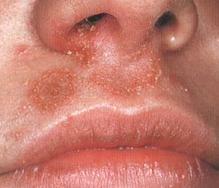 Staphylococcus in the nose is the presence in the nasal mucosa of a bacterium capable of causing a purulent-inflammatory disease.
Staphylococcus in the nose is the presence in the nasal mucosa of a bacterium capable of causing a purulent-inflammatory disease.
There are more than 20 varieties of Staphylococcus aureus, most of which are permanent companions of the human being and are normally present on the mucous membranes, including the nose.
At the same time, many staphylococci are absolutely harmless, only three kinds provoke the development of diseases. The most common among them is Staphylococcus aureus. It does not pose a threat to a person until the weakening of his immunity occurs.
Treatment of staphylococcus in the nose depends on the symptoms, and consists in the use of antibiotics, bacteriophages, immunomodulators.
How can I get infected?
Very often staphylococcus affects the nasal mucosa. You can get infected with bacteria in any public place, especially in polyclinics, hospitals and even the hospital.
Staphylococcal transmissionoccurs in such ways:
- airborne droplets;
- when using personal items of the patient;
- in the period of intrauterine development of the child, during labor or lactation;
- use of non-fresh or thermally unprocessed food;
- during injections or other medical procedures that take place within the walls of a medical institution.
Infection is manifested by purulent wound in the nose, but the disease can be complicated by sinusitis or even meningitis, so treatment of staphylococcus in the nose does not accept self-treatment.
Varieties
The most common bacteria are:
- Staphylococcus aureus, which is precisely because of its amber coloring received such a name.
- Epidermal Staphylococcus aureus, who loves to live on the skin and shells of the body, producing a mucous substance.
- Saprophytic Staphylococcus aureus, which actively resides in the genitourinary system.
- Haemolytic appearanceStaphylococcus, which has a special activity falling into the blood.
Symptoms of staphylococcus in the nose
 The nose and throat is one of the most "favorite" places of colonization of staphylococci in the human body. For the presence of staphylococcal infection in the nasal cavity may indicate certain symptoms (see. a photo):
The nose and throat is one of the most "favorite" places of colonization of staphylococci in the human body. For the presence of staphylococcal infection in the nasal cavity may indicate certain symptoms (see. a photo):
- nasal congestion;
- reddening of the mucous epithelium lining the nasopharynx;
- increased body temperature;
- a prolonged, uncontrollable runny nose;
- atrophy of the mucous epithelium of the nasopharynx;
- general intoxication (in some situations - toxic shock).
In some cases, infection of the nasopharynx with staphylococcus can be accompanied by the appearance on the nasal mucosa of small pustular formations.
Diagnostics
Sowing is used to determine the bacterium of staphylococcus aureus. The patient also takes a blood test. Thus, a conditionally pathogenic microflora is revealed in the patient's nasopharynx.
The patient is taken from a nasal smear on staphylococcus, laboratory tests are carried out with the help of enzyme immunoassay. After studying the results of the analysis, the patient is diagnosed.
In addition, tests for the sensitivity of staphylococcus to antibacterial drugs are carried out. in many cases, staphylococcus is not sensitive to the effects of antibiotics.
Treatment of Staphylococcus aureus in the nose and throat
It is necessary to know that treatment of this disease should be started only if the presence of bacteria in the nasal mucosa leads to the development of inflammation and the emergence of diseases: sinusitis, acute and chronic rhinitis, and other pathological disorders. Therefore, the patient must definitely give a smear on staphylococcus from the nose, which will show the clinical picture of the disease.
How to treat staphylococcus in the nose and throat? Before the start of therapyshould take into account the following circumstances:
- Staphylococcus easily develops resistance to certain antibiotics;
- Frequent use of antibiotics can lead to the emergence of a super resistant drug of Staphylococcus aureus;
- If the antibacterial agent is incorrectly selected, the effect is reversed: the infection is intensified and spread through the circulatory system throughout the body;
- Unqualified therapy leads to a number of serious complications: purulent skin lesion, osteomyelitis, endocarditis, intestinal intoxication, staphylococcal sepsis, meningitis.
Treatment is prescribed only after a survey to understand which strain of bacteria causes a health blow and what medicine will be able to overcome it. The most commonly prescribed sulfonamide or antibacterial drugs that are suitable for the patient individually.
Preparations
Fordestruction of bacteriaantibacterial drugs are used:
- Ofloxacin;
- Ceftriaxone;
- Oxacillin;
- Unazine;
- Amoxiclav.
In addition to the above, doctors appoint the followingsystemic drugs:
- Immunomodulators, which are designed to increase the overall resistance of the body (Tactivin, Poludan, Immunoriks);
- Antiallergenic drugs designed to remove puffiness (Ziretek, Tavegil, Diazolin);
- Vitamin complexes with the addition of a mineral component (Alphabet, Supradin, etc.).
Dosage and treatment can be prescribed only by the attending physician, from self-medication of such a serious infection should be categorically refused.

How to choose probiotics for the intestine: a list of drugs.

Effective and inexpensive cough syrups for children and adults.

Modern non-steroidal anti-inflammatory drugs.

Review of tablets from the increased pressure of the new generation.
 Antiviral drugs are inexpensive and effective.
Antiviral drugs are inexpensive and effective.



